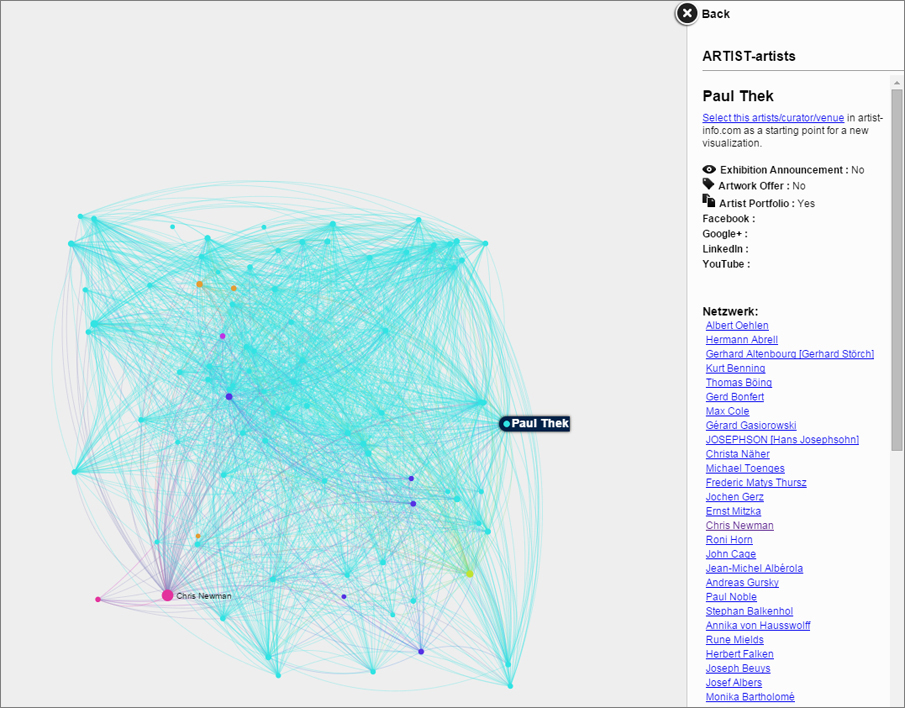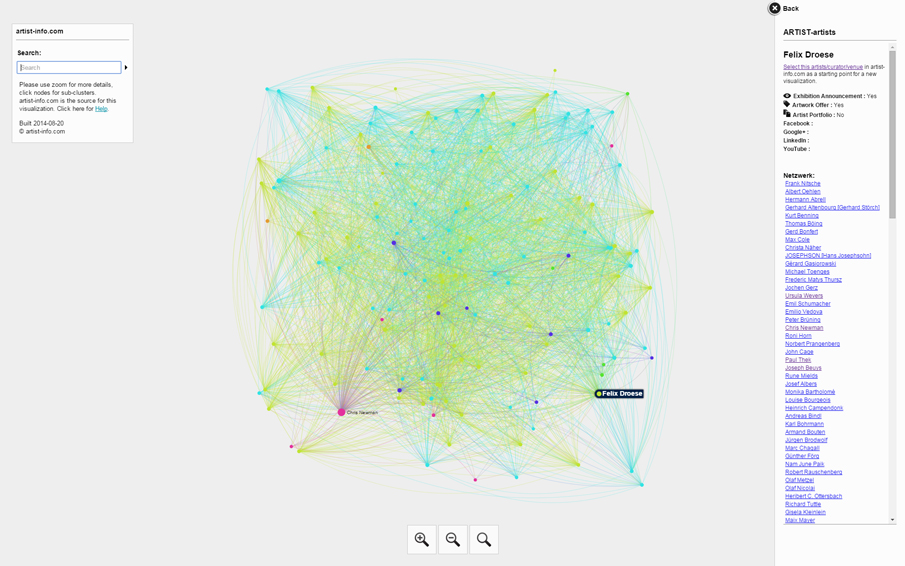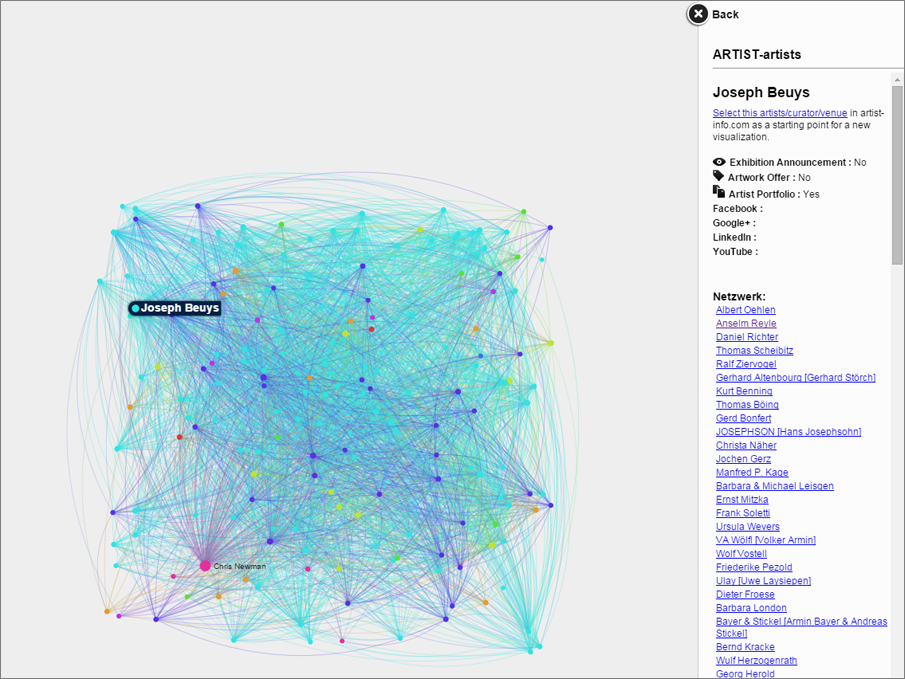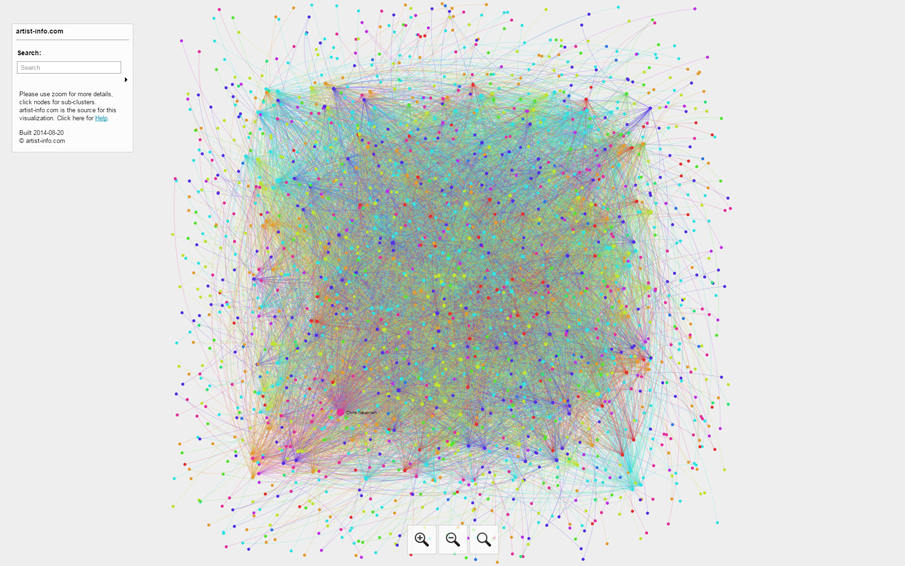To open this example of visualizing an ARTIST-artists network in a new browser window click on the image or here.
Find on our Overview page details on how to best navigate and use all features of the interactive ‘Visualizing Art Networks’ browser windows.
Visualizing Art Networks – ARTIST-artists Example
This ARTIST-artists example is about the artist Chris Newman and the artists he was connected with through showing their artwork together. All related exhibitions for this insight can be found on Chris Newman‘s artist-info page.
This ARTIST-artists point of view is complemented by our ARTIST-venues point of view. It visualizes all exhibition places in artist-info database of an artist and how they are building networks through showing the same artists and their artwork.
The following details describe the visualized network. They are summarized at the bottom of the page with Benefits.
How to read the visualized networks
CENTER – In this example the center of the visualized networks is the artist Chris Newman. All queries of artist-info database for the visualized networks are related to this artist.
For Chris Newman artist-info knows of 40 solo- and 32 group-exhibitions, in commercial galleries, museums, non-profit places and collector’s venues, from 1982 – 2015, worldwide.
BEFORE / after – An ordinary artist’s CV would give you a list of these exhibitions and where they took place but wouldn’t show all the artists Chris Newman did show his work together with, although it is basic information for the artist’s profile and to position the artist.
before / AFTER – artist-info visualizing analytics finds 430 artists who were shown together with Chris Newman. To list them all in the right side pane click on ‘Chris Newman’ in the network heap.
Different to an ordinary CV the artist’s cross-linked exhibition history in artist-info gives you the possibility to look up each group-exhibition and the participating artists, curators, and exhibition places.
They are all part of the large wad you see above.
The search option on the left helps to find a specific artist among all 430 artists. The search result is listed in the right side pane. Details on how to use the right side pane can be found on our Overview page.
CLUSTERS / SUB-CLUSTERS – Zooming in and selecting with your mouse an artist unfolds the important capacity and value of artist-info ‘Visualizing Art Networks’.
You will find different groups of artists building clusters with the CENTER, Chris Newman. The clusters are showing not only the relation between Chris Newman and each of the cluster’s artists but as well how the members of the cluster are connected among each other, one more, some less, showing their dominance (shade of color) through the known details like the number of times showing together and the number of etches with other network members.
The list of the cluster’s artists in the right side pane helps to further select sub clusters, identifying (e.g. mouse over), further filtering, and selecting, exploring, discovering, evaluating artists in the network.
PROPAGATION – How to find options for new connections?
The big heap of the starting image is surrounded by single dots at the end of a line / edge. These single dots represent artists who are most likely important new associations for the CENTER artist as a result of the artist-info algorithm. They have the highest number of exhibitions with the related network cluster member but not directly with the CENTER artist, Chris Newman.
To go back to the starting image click on ‘Chris Newman’ and then on ‘Back’ at top of the right side pane.
SOURCE – Where does all this information come from? The link under the artist’s name in the header of the right side pane opens the artist’s artist-info page with all the details of solo- and group-exhibition history which was used for this ‘Visualizing Art Networks’ analytics.
It is the first time these amazing relations can be shown and no list or table could give you this overview and insight.

This is the result if you select from the list of 430 the artist Paul Thek. The cluster shows all 89 artists related to Paul Thek in Chris Newman’s network. The color is related to the number of connections with Chris Newman.
The green dot on the lower right belongs to Felix Droese with 148 connections to the 430 artists in Chris Newman’s network.

All exhibitions of Paul Thek in artist-info database and his many more connections shows his artist-info page, and those of Felix Droese can be found on this artist-info page.

Selecting Joseph Beuys from the list of 430 artists does show this sub-cluster.
There are 181 other artists related to Chris Newman and Joseph Beuys. The color is similar to the one of Paul Thek.
All exhibitions of Joseph Beuys in artist-info database and his many more connections shows his artist-info page.
Benefits
This ARTIST-artists insight can be created for each of the 159.600+ artists in artist-info database and is complemented best by visualizing the ARTIST-venues networks as the second important point of view for an artist.
The displayed network clusters are not dynamically following updates of artist-info database.
 NEIGHBORHOOD – Visualizing Art Networks’ for an artist by showing the connections to other artists through exhibitions at galleries, museums, non-profit-places, or collector venues is a new, first time ever possibility to show the neighborhood of an artist. As described above the interactive visualized network does show much more than a simple list of names could reveal.
NEIGHBORHOOD – Visualizing Art Networks’ for an artist by showing the connections to other artists through exhibitions at galleries, museums, non-profit-places, or collector venues is a new, first time ever possibility to show the neighborhood of an artist. As described above the interactive visualized network does show much more than a simple list of names could reveal.
 PROFILE – The individual profile of an artist is an important value for positioning the artwork. An important key for this value are to some degree similar aspects as well as aspects different to each other’s artwork of the artists in a sub-cluster.
PROFILE – The individual profile of an artist is an important value for positioning the artwork. An important key for this value are to some degree similar aspects as well as aspects different to each other’s artwork of the artists in a sub-cluster.
 SUPPORT – The visualized networks can help to develop valuable connections now visible through the network graph.
SUPPORT – The visualized networks can help to develop valuable connections now visible through the network graph.
 WEIGHT – Which artist dominates the neighborhood? The number of edges to other members shows the importance of each member.
WEIGHT – Which artist dominates the neighborhood? The number of edges to other members shows the importance of each member.
 GET INSPIRED – Showing the other artists in the neighborhood and the way they are connected to the CENTER is an important source for possible new exhibitions.
GET INSPIRED – Showing the other artists in the neighborhood and the way they are connected to the CENTER is an important source for possible new exhibitions.
A second important information for new associations are the artists selected by artist-info’s propagation algorithm and displayed as single points around the basic network image.
 NEW ASSOCIATIONS – The big heap of the starting image is surrounded by single dots at the end of a line / edge. These single dots represent artists who are most likely important new associations for the CENTER artist. They have the most exhibitions with a network cluster member but are not yet directly connected with the CENTER artist.
NEW ASSOCIATIONS – The big heap of the starting image is surrounded by single dots at the end of a line / edge. These single dots represent artists who are most likely important new associations for the CENTER artist. They have the most exhibitions with a network cluster member but are not yet directly connected with the CENTER artist.
To go back to the starting image click on ‘Chris Newman’ and then on ‘Back’ at top of the right side pane.
Support
More details and how to use or customize Visualizing Art Networks for your project can be found on artist-info Help page / VISUALIZATION.

